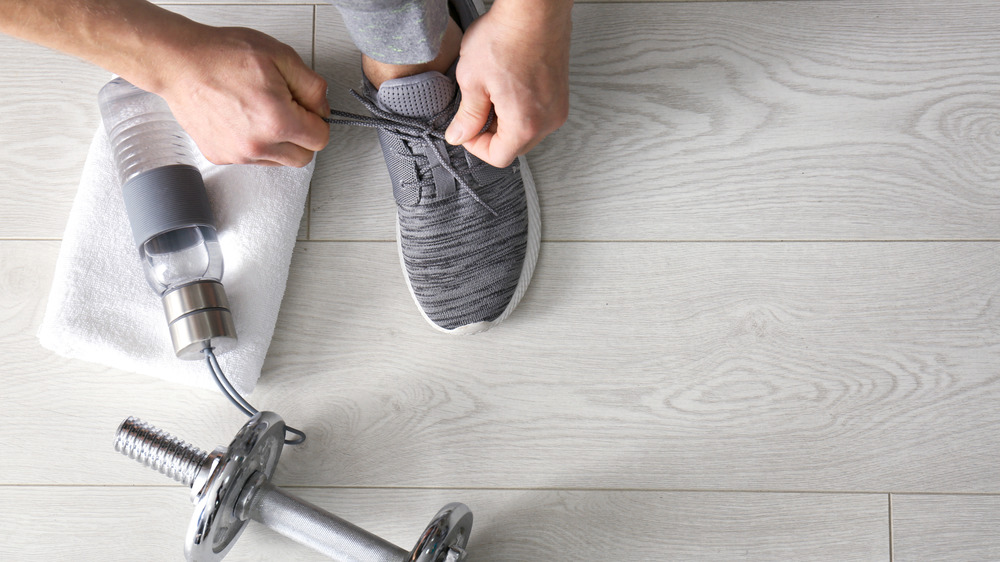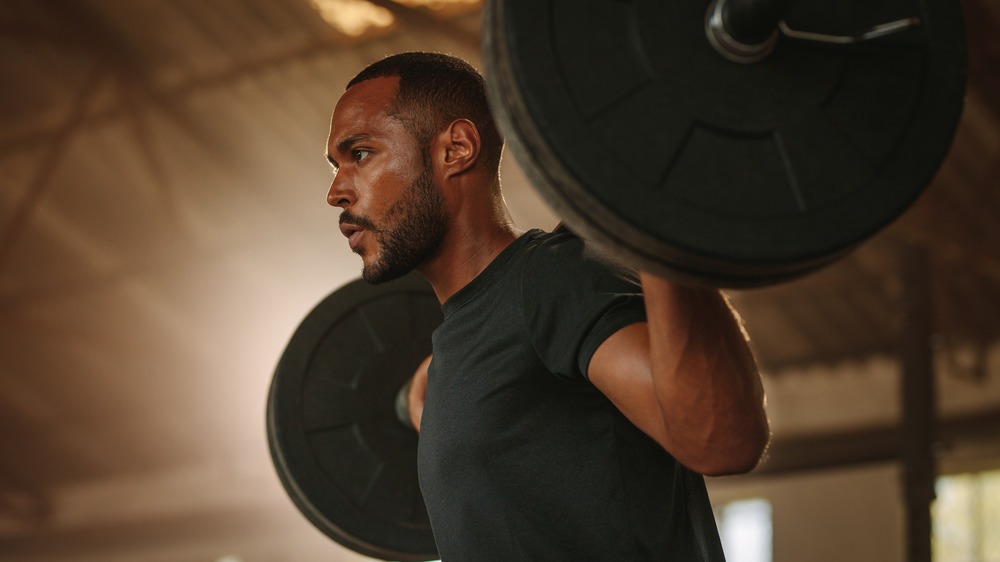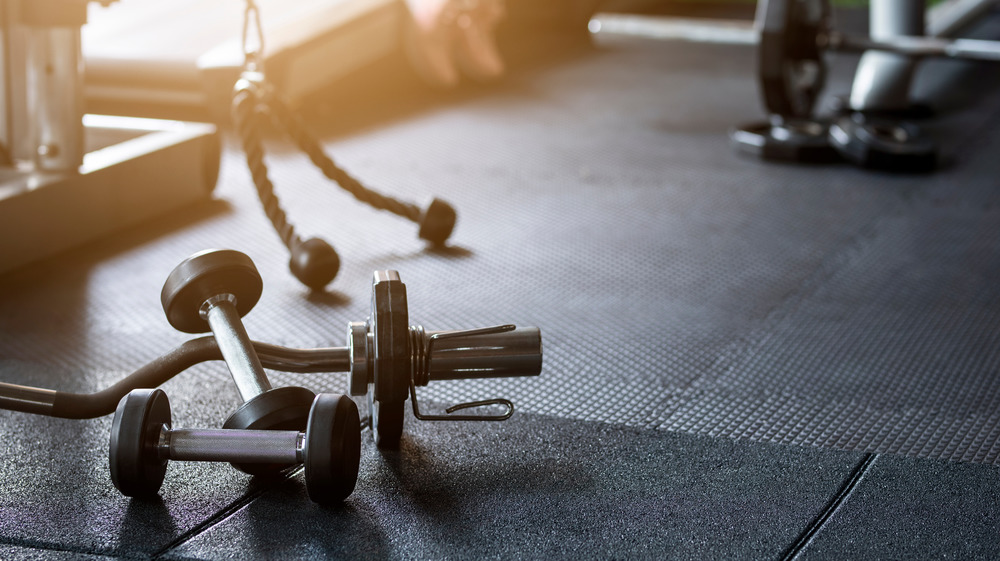The Worst Mistakes Everyone Makes When Lifting Weights
Weightlifting isn't just for the bodybuilders out there. Lifting weights regularly can compliment pretty much any workout plan. Whether you're a runner, swimmer, or just someone simply looking to gain a little extra strength and definition, strength and resistance training are important aspects of supporting good bodily function and health.
According to the Mayo Clinic, strength training not only helps us burn calories and build lean muscle mass, but it can also help to increase our bone strength, manage chronic conditions (like arthritis, depression, and diabetes), and improve cognitive function. And the best part? There's no need to trek to a gym to do it. With a few simple pieces of equipment and a bit of floor space, it's easy to do in the comfort of your own home (via Healthline).
Nevertheless, there are a ton of blunders that can be made while weightlifting — and these mistakes can not only hold back your progress but also lead to aches, pains, and injury. Let's check out some of the most common mistakes people make so you can learn to avoid them — and so you can get those sweet, sweet gains.
Mistake: Skipping the warmup
Before you even reach for your first dumbbell, there's work to do. A good warmup is essential to any weightlifting session. Without warming up, you risk putting yourself at risk of injury when strength training. As Dr. Bill Kelley, physical therapist and strength coach, said in an interview with Men's Journal, "Warm-ups are crucial to heating up muscle tissue, improving tissue extensibility, decreasing internal tissue resistance, and increasing the amount of tissue deformation that can occur before you break the threshold into injury."
Without a warmup, you're essentially going in cold, which can cause muscle strain or other injuries. Lifting weights without warming up can also hinder your workout. As a review published in the Journal of Strength and Conditioning Research found, warming up before exercise increases your subsequent physical performance.
Although it's easy to want to skip the warmup and get straight to it, making sure your body is ready is vital. As Gold's Gym suggested, full-body exercises like jumping jacks, light cardio, and stretching are all great ways to get your body into a good place before strength training.
Mistake: Not giving your body enough fuel beforehand
Not eating enough before a workout is an easy mistake to make, particularly if your exercise goals include losing weight. But without fueling your body sufficiently, you could be in for a joyless session.
As Livestrong explained, working out without eating enough, or on an empty stomach, means you may have less stamina or feel more fatigued when exercising. "If you exercise for long periods or do high-intensity workouts, you will be more likely to suffer from low blood sugar and fatigue if you have not eaten for several hours," the publication continued. If your food intake is consistently low, it can eventually cause you to even lose muscle mass due to your body burning muscle tissue as an energy source. This means your weightlifting sessions could even end up being counterproductive.
To avoid this mistake, eat sufficiently before exercise — aiming for a balanced combination of protein and carbohydrates, as Medical News Today outlined. Eating a good amount of protein (20 to 30 grams) before weight training can help boost muscle "protein synthesis," helping with muscle growth, as the site explained.
Mistake: Not allowing your body time to recover
When we exercise, it's natural to want the quickest results possible. And sometimes, that can result in working out all the time. This can be a pretty big mistake, though — particularly when it comes to weight training.
Without leaving time for your body to recover, you run the risk of overtraining — and this can lead to a host of problems. As Bodybuilding.com explained, overtraining can have precisely the opposite effect you want from weight training: It can leave your body even weaker than it was before, due to your muscles being overworked. This can lead to a general loss of enthusiasm for weight training, persistent fatigue and muscle soreness, irritation, and increased risk of injury. In more profound cases, working out too much can even result in insomnia and depression.
To avoid this, give your body enough time between workouts, and rest those sore muscles. It's important, too, as Verywell Fit pointed out, to take rest days. This allows your body time to rebuild your muscles and refuel for future exercise.
Mistake: Failing to consider the order of your workouts
On the surface, weightlifting seems pretty simple: Lift things up, put them down. Rinse, repeat — and then get bigger, right? Well, it's a bit more detailed than that. When you're lifting weights, it's important to think about your exercise program as a whole (via Verywell Fit). That is, the order in which you're going to exercise, the muscle areas you're going to focus on, and for how long and how many reps you plan to perform across all your different workouts. Diversifying your workout — not just lifting weights — can have plenty of benefits (via PartnerMD).
By doing this, you'll not only make sure you're covering all the targets you want to hit through lifting weights, but you'll also avoid any mistakes which might inhibit your goals. However, the order does matter. If your goal is to increase muscle mass, doing cardio before weightlifting isn't a great bet. As a study published in the Journal of Strength and Conditioning Research showed, this order can harm weightlifting performance. Consider your goals, and plan your fitness program accordingly (via Women's Health).
Mistake: Holding your breath
When we put our bodies under stress, as we do when lifting weights, it's a pretty natural impulse to want to hold our breath. But when weight training, not breathing properly is a mistake that can cost you big.
As exercise physiologist Christopher Travers explained in an interview with Cleveland Clinic, "Holding your breath as you're lifting weights can lead to a rapid increase in your blood pressure". This increase in blood pressure is problematic at the best of times, but can, in some cases, cause a hernia when lifting weights. According to Travers, holding your breath while lifting weights can cause you to lose consciousness (aka pass out).
As none of these things are particularly pleasant, it's important to make sure you're breathing through any weightlifting session, but particularly during heavier, more strenuous exercises. To help regulate your breathing, use the rhythm of breathing out when you lift or exert effort, and breathe in when you return to a resting position. By doing this, you'll maintain oxygen flow through your body and avoid dangerous blood pressure increases.
Mistake: Never adding more weight
When lifting weights, you put stress on your muscles, which then causes your muscles to adapt and become stronger, eventually leading to increased muscular power and a fitter physique (via Mayo Clinic). However, it's important to make sure you're continuing to test your muscles as they adapt. And although this seems obvious, it's something that people can fail to consider when following a weight training program. Instead, people often opt for the same weights over and over again, which as your muscles get stronger, can have diminishing returns.
It's vital to make sure that as you get stronger, the weights you lift get heavier — particularly if you're looking to build lean muscle mass. To sustain gains, make sure that you have an exercise plan that continues to challenge your body by consistently adding resistance and weight, Bodybuilding.com advised.
It's important to remember that this approach is primarily for building mass. If you're looking for definition, focus instead on a range of lifts and squeezing your muscles with each rep. And regardless of your personal goal, make sure you're challenging yourself with each workout.
Mistake: Being inconsistent
With most things in life, consistency and commitment are the keys to success — and it's really no different when it comes to lifting weights. That's why, particularly if you're new to weightlifting, developing a routine you can stick to is important. "Without consistency, programs are unorganized, the body has a harder time adapting, and forming habits may be more challenging," the National Institute for Fitness and Sport explained.
As Harvard's Healthbeat suggested, aim to perform strengthening exercises for the major muscle groups — your "legs, hips, back, chest, abdomen, shoulders, and arms" — twice a week or more. If you're just starting out, try not to worry about how much, or how little, weight you're able to lift. In fact, the Harvard publication revealed, "When learning a strength training routine, many experts suggest starting with no weight, or very light weight. Concentrate on slow, smooth lifts and equally controlled descents while isolating a muscle group."
You should also sure you're leaving enough rest time (ideally two full days) between weight-training sessions in order to give your muscles time to recover. And perhaps most importantly, stick to a routine as much as possible to get the best results.
Mistake: Forgetting about your form
When developing a weightlifting program, there are many things to consider, but when you're in a weightlifting session, your should spend much of your time focusing on your form. Having the correct form when weight training enables you to access all of the benefits that strengthening exercises offer: Increasing strength and muscle tone, fat burning, and strengthening bone density.
When we have the incorrect form, not only are these effects nullified, but it can also be seriously unsafe. Incorrect form when weight training means we're straining our bodies incorrectly, which can lead to sprains, fractures, tears, and other injuries (via Mayo Clinic). It's perhaps the quickest way to kill your results and cause serious harm.
If you're new to weightlifting, it's useful to work with a personal trainer or weight training specialist to perfect your form — and it's even prudent once you've become a seasoned lifter, as it can help keep you on track as you add more and more weight.
Mistake: Using weights that are too heavy
It's easy to see the logic here, flawed as it may be. Lifting weights calls for picking up heavy things to get stronger. Therefore, the heavier that stuff is, the stronger you'll get. Makes sense, yes? Unfortunately, it's not that simple.
By lifting weights that are too heavy for your targeted muscle's strength, your body ends up using other muscles in an attempt to lift the load. This means your form will end up suffering (via NBC News). Choosing weights that are too heavy could cause further problems. As Kristina Alai, a fitness trainer at The Bay Club Company, told NBC News, "This is a recipe for injuries and will not be the quick fix to make you stronger." What you think will be helping you achieve results could, in fact, be hindering them.
Instead, use appropriate weights.As Verywell Fit suggested, pick weights that allow you to perform 10 reps with "moderate difficulty." By the final rep, you "should find it somewhat difficult to lift but not so difficult as to strain, hold your breath, or shake excessively," the publication explained. Add more weight when your strength increases to the point that you can perform the third set easily.
Mistake: Focusing only on specific muscles
If you want rippling arms or a toned butt, weightlifting is a pretty safe bet — when following a regular training plan with the right nutrition, of course. But if you dream of a specific look, focusing solely on the muscles you care about most isn't necessarily the best way to get there.
Isolation exercises, such as bicep curls and leg extensions, can be a great way to target individual muscles to gain specific results. Although, as Nuffield Health highlighted, there are no exercises that will use just one muscle group; isolation exercises merely focus on specific areas.
There are also drawbacks to isolation exercises — one of them being the unbalanced development of muscles. If the opposite (or antagonist) muscle isn't also being developed (think: biceps and triceps), you can end up with one muscle much stronger than the other, leading to problems with balance and correct motion, Verywell Fit explained. Making sure you're giving proper attention to all of your muscles — or focusing on compound exercises that work multiple muscle groups — is a good way to avoid disparities.
Mistake: Not leaving yourself enough time to recover from injuries
If you've suffered an injury while working out, it can be pretty frustrating to wait to get back to full health before hitting the gym again. But wait you must. If you don't, it can lead to some serious problems.
If you've incurred an injury through weightlifting, returning to exercise before your body's ready to exercise again can lead to re-injury or the development of chronic issues — and those will lead to even longer recovery times (via Verywell Fit). In addition to lifting weights using the correct form and making sure you warm up and cool down adequately, maintaining a good level of general fitness can help to prevent injuries.
Treating an injury right away will help you recover faster. And as much as you may want to rush through your recovery time, remember time is an important part of healing. Once you feel you've fully recovered, consult a healthcare professional before initiating any exercise again (via WebMD). Make sure to take things slow, and listen to your body — more often than not, it'll tell you if you need more time.
Mistake: Ending your workout without a snack
Although a lot of emphasis gets placed on making sure you're adequately fueled before a workout to have enough energy to hit it hard, eating properly after exercise is also vital. Yes, avoid the mistake of skipping that post-workout protein shake.
When you exercise, your body breaks down the glycogen stored in your muscles and turns it into glucose for energy (via Cleveland Clinic). Once you're finished working out, your glycogen stores are depleted. If you don't restore them through the right food — a combination of carbohydrates and protein ideally within 30 minutes to three hours – it can impede your recovery and energy levels (via Verywell Fit).
According to a 2017 study in the Journal of the International Society of Sports Nutrition, as little as 9 grams of milk protein can help to stimulate protein synthesis in muscles, which helps them recover. Avoid the mistake of forgoing food after a workout, and aim to consume a post-workout snack. And don't forget to drink water shortly after finishing your weightlifting session.
Mistake: Never reducing the amount of weight you lift
By only using one weight — as in the same amount of pounds — per workout, you may be unintentionally slowing down your gains. Although it's wise to increase the amount of weight you lift as you get stronger, reducing the amount of weight you can also help promote muscle growth.
This was confirmed in a study published in the Journal of Strength and Conditional Research (via Medical News Today). The study found that when weightlifters vary the weight they lift while training by reducing the weight on certain days, they can actually end up enhancing their performance and strength. While the researchers behind the study stressed that lifting too little won't stimulate muscle growth, lifting slightly less will help weightlifters experience less muscle fatigue and aid recovery. It also helps prevent injury. As such, by switching up the amount of weight you're lifting per day, you may end up having even better workouts.
Mistake: Skipping the cooldown
Once you've finished lifting weights, you might be feeling the burn in your muscles. But instead of flopping down on the couch, take a little extra time to stretch out those muscles you've just worked. Your body will thank you for it.
As certified personal trainer Jeremey DuVall wrote in an article for Men's Journal, lifting weights contracts your muscles, which leaves them shortened. By stretching out the muscles you've used, you're helping to reset your body to its natural posture and positioning, helping to reduce later stiffness and soreness.
Furthermore, stretching your muscles after working out increases the blood flow to them, as demonstrated by a 2018 study published in The Journal of Physiology. By helping blood reach your muscles, they're then able to heal at a faster pace — meaning that you'll be able to hit the gym quicker (via Healthline). The next time you finish a weightlifting workout, spend an extra five to ten minutes practicing some dynamic or static stretching. We're sure you'll be pleased with the recovery time.















